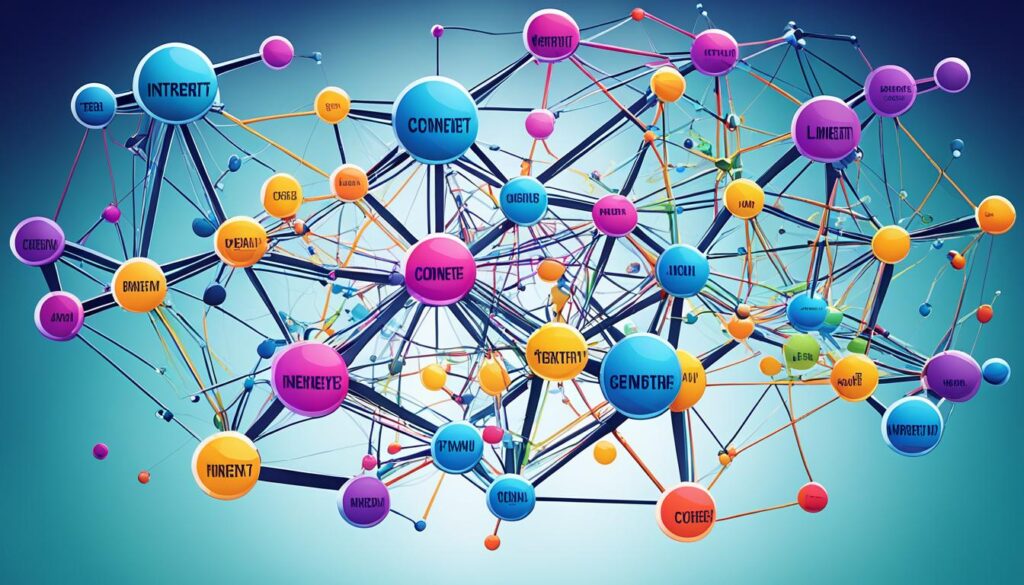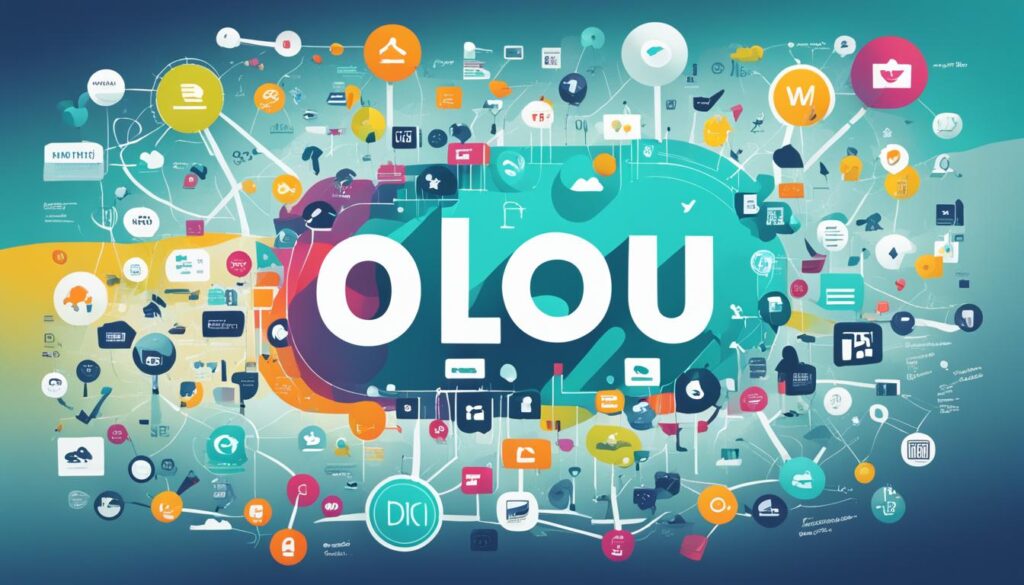Welcome to the digital era where Web 2.0 has reshaped the way we interact with the internet. In this article, we will explore the concept of Web 2.0, its technologies, tools, platforms, and applications. Let’s dive in and grasp the essence of this transformative phenomenon.
Key Takeaways:
- Web 2.0 represents the current state of the internet, characterized by user-generated content and interactivity.
- Not a specific technical upgrade, Web 2.0 emphasizes information sharing, collaboration, and interconnectedness.
- Popular Web 2.0 examples include social media platforms like Facebook, Twitter, Reddit, TikTok, and collaborative websites like Wikipedia.
- Advantages of Web 2.0 include improved communication, collaboration, targeted marketing, and equitable opportunities for individuals.
- Disadvantages of Web 2.0 include cybersecurity risks, misinformation, information overload, and potential exploitation by bad actors.
What Is Web 2.0?
Web 2.0 represents the current state of the internet, characterized by a significant increase in user-generated content and enhanced usability compared to its predecessor, Web 1.0. Unlike a specific technical upgrade, Web 2.0 signifies a fundamental shift in how the internet is utilized. It prioritizes information sharing, collaboration, and interconnectedness among participants, allowing for the development of various innovative applications and platforms.
Web 2.0 technologies facilitate active user involvement, enabling individuals to contribute, share, and interact on a global scale. This shift towards user-generated content has resulted in the rapid growth of popular social media platforms such as Facebook, Twitter, Reddit, TikTok, and informative platforms like Wikipedia. With Web 2.0, the internet has transformed into an interactive and dynamic space where users can actively engage with content.
“Web 2.0 empowers individuals to actively participate, collaborate, and share in the online world, shaping the internet into a more interactive and user-driven platform.”
Web 2.0 serves as the foundation for the development of Web 3.0, where the internet is set to become even more interconnected, intelligent, and responsive to user needs. This continual evolution fosters an ever-expanding digital landscape with endless possibilities for communication, collaboration, and innovation.

Understanding Web 2.0
Web 2.0 has revolutionized the way we use the internet, placing a greater emphasis on user engagement and interaction. This shift has given rise to various platforms and tools that allow users to create and share content, leading to a more dynamic online experience. Let’s explore some examples of Web 2.0 sites, platforms, and tools that have transformed the digital landscape.
Web 2.0 Examples
Web 2.0 examples encompass a wide range of websites and applications that facilitate user-generated content and collaboration. Some notable examples include:
- Wikipedia: The crowd-sourced online encyclopedia where users can create and edit articles.
- Facebook: The popular social networking platform that allows users to connect, share, and communicate with friends and family.
- Twitter: A microblogging platform that enables users to share short messages or “tweets” with their followers.
- Blogs: Platforms such as WordPress and Medium that empower individuals to publish and share their thoughts and expertise.
These examples represent just a fraction of the diverse range of websites and platforms that embody the principles of Web 2.0.
Web 2.0 Platforms and Tools
Web 2.0 platforms and tools provide users with the means to engage and collaborate in various forms. Some popular platforms and tools include:
- WordPress: A versatile content management system (CMS) that powers millions of websites, allowing users to create and publish content easily.
- Medium: A platform that focuses on long-form content and provides a space for writers and bloggers to share their ideas and expertise.
- Social Media Platforms: Facebook, Twitter, Instagram, and LinkedIn are just a few examples of social media platforms that offer users a space to connect, share, and engage with others.
These platforms and tools have democratized content creation and distribution, enabling individuals and businesses to have a voice and connect with audiences globally.

The image above depicts the diverse ecosystem of Web 2.0 tools available to users.
Web 2.0 continues to evolve, with new platforms and tools constantly emerging. The ability for users to actively participate and contribute to the online world has transformed the way information is shared and consumed, ultimately shaping our digital experiences.
Advantages and Disadvantages of Web 2.0
Web 2.0 has revolutionized the way we interact and engage on the internet. With its user-centric approach, it offers a wide range of benefits that have transformed various aspects of our lives. However, it also comes with its own set of challenges and drawbacks. Let’s take a closer look at the advantages and disadvantages of Web 2.0.
Advantages of Web 2.0
Improved Communication: Web 2.0 platforms such as social media, online forums, and messaging apps have opened up new avenues for communication. It allows individuals and businesses to connect and share information globally, fostering stronger relationships and collaborations.
Collaboration and Knowledge Sharing: Web 2.0 promotes collaboration and knowledge sharing by providing tools for real-time collaboration, document sharing, and project management. Team members can work together efficiently, even from remote locations, resulting in increased productivity and innovation.
Targeted Marketing Approaches: Web 2.0 enables businesses to reach their target audience more effectively through personalized advertising, content marketing, and data-driven insights. This targeted approach ensures that marketing efforts are more relevant and yield better results.
Equitable Opportunities: Web 2.0 provides equal opportunities for individuals to share their views, talents, and creations with the world. It has given rise to content creators, influencers, and entrepreneurs who can build networks, gain recognition, and monetize their skills on various platforms.
Disadvantages of Web 2.0
Cybersecurity Risks: As Web 2.0 relies heavily on user-generated content and data sharing, it opens up avenues for cybercriminals to exploit vulnerabilities. From phishing attacks to identity theft, users and businesses need to be vigilant and adopt robust security measures.
Misinformation: With the ease of content creation and sharing, Web 2.0 has become a breeding ground for misinformation and fake news. It is crucial for users to critically evaluate the information they come across and rely on trusted sources.
Information Overload: The abundance of information on the internet can be overwhelming. Web 2.0 presents users with vast amounts of data, making it challenging to filter and process relevant information effectively.
Exploitation and Abuse: The openness and anonymity of the internet can lead to instances of online harassment, cyberbullying, and other forms of abuse. Web 2.0 platforms must implement robust moderation and reporting mechanisms to combat these issues.
Web 2.0 benefits society in numerous ways, enabling communication, collaboration, access to knowledge, and targeted marketing. However, it also brings forth challenges that need to be addressed to ensure a safe and reliable digital environment.

| Advantages | Disadvantages |
|---|---|
| Improved communication | Cybersecurity risks |
| Collaboration and knowledge sharing | Misinformation |
| Targeted marketing approaches | Information overload |
| Equitable opportunities | Exploitation and abuse |
Web 2.0 vs. Web 1.0
The evolution from Web 1.0 to Web 2.0 brought about significant changes in the way the internet functions. Web 1.0, the initial stage of the internet, was characterized by static web pages and limited user interaction. It primarily served as a platform for information dissemination.
Web 2.0, on the other hand, revolutionized the internet by emphasizing collaboration, user-generated content, and social networking. It introduced dynamic web pages, enabling increased user control and greater interactivity. This shift transformed the online landscape from a passive information source to a vibrant, user-driven environment.
Web 2.0 technologies and features empower individuals to actively participate and contribute to the digital world. It enables the creation and sharing of user-generated content across platforms and facilitates real-time communication and collaboration.
Web 1.0 emphasized information, while Web 2.0 emphasizes interaction and participation.
To further illustrate the distinctions between Web 1.0 and Web 2.0, let’s compare their key characteristics:
| Web 1.0 | Web 2.0 |
|---|---|
| Static web pages | Dynamic web pages |
| Passive user experience | Interactive and participatory user experience |
| Centralized content creation and control | User-generated content and decentralized control |
| Limited user engagement | Extensive user engagement, collaboration, and social networking |
Web 2.0’s emphasis on interactivity and user-generated content has led to the rise of various platforms and technologies that enable social media, blogging, video sharing, and more. This user-centric approach has transformed the internet into a dynamic and interconnected ecosystem.

While Web 1.0 focused on providing information, Web 2.0 thrives on fostering user engagement, collaboration, and social connections. It has fundamentally reshaped the way we interact with the digital realm, allowing us to participate actively in shaping the online experience.
Conclusion
Web 2.0 has revolutionized the way we interact with the internet. With its emphasis on user-generated content and interactivity, it has transformed the digital landscape. Platforms like Facebook, Twitter, and Instagram have become integral parts of our daily lives, enabling us to connect with others and share our thoughts and experiences.
The development of Web 2.0 has also led to the creation of various applications and tools that enhance our online experience. From web-based email clients to collaborative project management platforms, Web 2.0 has opened up new avenues for communication, collaboration, and productivity.
However, along with its benefits, Web 2.0 also presents challenges. Cybersecurity threats and the spread of misinformation are growing concerns in this interconnected world. It is crucial for both users and platform providers to stay vigilant and address these issues to ensure a safe and reliable online environment.
The comparison between Web 2.0 and its predecessor, Web 1.0, highlights the evolution of the internet. While Web 1.0 focused on static content and limited user interaction, Web 2.0 brought about a paradigm shift in user engagement and content creation. As we look towards the future, the development of Web 3.0 promises even greater interconnectivity and intelligence, paving the way for exciting advancements in the digital realm.
FAQ
What is Web 2.0?
Web 2.0 refers to the current state of the internet, characterized by a shift in how it is used compared to its earlier incarnation, Web 1.0. It emphasizes user-generated content and interactivity, leading to the development of applications like Facebook, Twitter, Reddit, TikTok, and Wikipedia.
How would you define Web 2.0?
Web 2.0 describes the current state of the internet, with more user-generated content and usability compared to Web 1.0. It is not a specific technical upgrade but a shift in how the internet is used. It promotes information sharing and interconnectedness among participants, enabling the creation of applications like Facebook, Twitter, Reddit, TikTok, and Wikipedia. Web 2.0 paves the way for Web 3.0.
When did Web 2.0 emerge?
Web 2.0 emerged in the late 1990s as the internet shifted towards active user engagement. It allows users to provide content and interact with others through social media platforms, blogs, and self-publishing tools like WordPress and Medium. Examples of Web 2.0 sites include Wikipedia, Facebook, Twitter, and various blogs. The shift to Web 2.0 transformed the way information is shared and delivered.
What are the advantages of Web 2.0?
Web 2.0 offers advantages such as improved communication, collaboration, and knowledge sharing. It allows for targeted marketing approaches and equitable opportunities for individuals to share their views and build networks. However, there are also disadvantages such as cybersecurity risks, misinformation, information overload, and the potential for bad actors to exploit the openness of Web 2.0.
How does Web 2.0 differ from Web 1.0?
Web 1.0 was the first stage of the internet, characterized by static pages and limited user interaction. Web 2.0, on the other hand, emphasizes collaboration, user-generated content, and social networking. The shift from Web 1.0 to Web 2.0 introduced dynamic content, increased user control, and greater interactivity. Web 2.0 is more social and interactive-driven, while Web 1.0 is more informative and data-driven.
What does Web 2.0 offer?
Web 2.0 represents a significant shift in the way the internet is used, with a focus on user-generated content and interactivity. It has paved the way for the development of social media platforms, web applications, and self-publishing tools. Web 2.0 offers advantages in communication, collaboration, and marketing, but there are also disadvantages related to cybersecurity and misinformation. The comparison between Web 2.0 and Web 1.0 highlights the evolution in user interaction and content creation. With the development of Web 3.0, the internet is set to become even more interconnected and intelligent.








